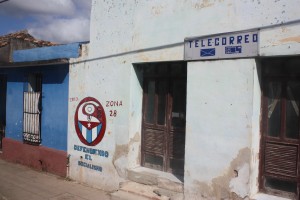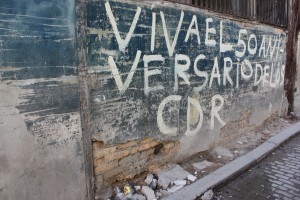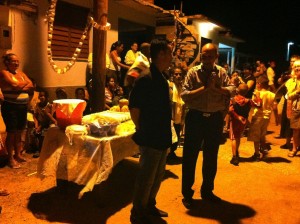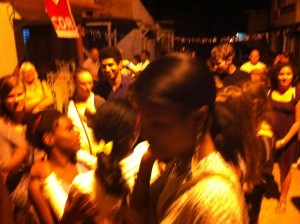CDR: A Two-Sided Story
April 3, 2012 by ismoore
Wherever we were in Cuba, the acronym “CDR” seemed to be too. It was sprayed onto sides of buildings, lampposts, and fences. Even on our rickety horse-drawn cart ride to the botanical garden outside Cienfuegos, deep in rural farmland, “CDR” made an appearance as a rock formation in front of a small run-down house. Many of us naturally began to ask: What is this CDR?
We got to experience it first-hand when we went to a local CDR meeting in Trinidad. CDR stands for “Comités de Defensa de la Revolución” or Committees for the Defense of the Revolution. Since this was a mandatory activity scheduled by ICAP (the Cuban Institute of Friendship with the Peoples), I was wary about its authenticity. I expected an official sit-down meeting during which leaders would discuss politics and feed us socialist propaganda. To my surprise, our walk through the cobblestone streets of Trinidad led us to the equivalent of an American block party. A group of about 50 Cubans of all ages was awaiting our arrival in a small outdoor space between their homes. Their doors and windows were wide open, allowing intimate moments to seep into the street, blurring the line between public life and private life. Colorful paper chains hung between rooftops and a wooden table was plump with cake and fruity drinks. After a brief welcome and introduction by the leader of the CDR, the local Cuban children took to the floor with poetry readings, traditional dances, and an exhilarating (and humorous) fashion show. Then the children began to salsa dance, gradually pulling Vassar students and professors into the crowd, until we’d become a jumbled mix of 5-year-olds, 20-year-olds, 60-year olds, males and females, awkward American dancers and talented Cuban ones, all moving to the same rhythm, getting a sense of one another’s culture and mannerisms. By the end of the evening, my original understanding of the CDR was completely different than it had been when we’d arrived. The meeting had been so informal and we had not been bombarded with political marketing. The CDR seemed to be a tool for community development, a method of fostering a sense of belonging among its members and establishing trusting relationships.
Yoél’s description of the CDR generally fit our first-hand experience: The largest non-governmental organization in Cuba, it was founded in 1960 by Fidel Castro. Every neighborhood/district has a CDR and the main goal is to create a cohesive community and work towards social change on a local level. It is completely voluntary and does not receive government funding, but millions of Cubans are members. The CDR organizes vaccinations and blood drives (they donated blood to the United States after Hurricane Katrina), and its members campaign against the arrest of the Cuban 5.
Yoél’s insistence that the CDR is completely citizen-run and apolitical made me wonder: How could the local defense of the revolution, initiated by Fidel Castro himself, be so disassociated from the communist regime? When I returned to the U.S, I did further research and discovered that there are two sides to the CDR story. The CDR was originally, and still is to a certain extent, responsible for seeking out dissidents and counterrevolutionaries. CDR leaders keep a detailed report of all neighborhood members: names, addresses, occupations, and political views. Though the government does not support the CDR financially, the CDR is a direct player in ensuring the implementation of socialism. Yoél put the CDR in an exclusively positive light, but opinions about the CDR are varied. Critical voices complicate our benevolent impression of the CDR. A 2010 article by the French news agency AFP notes that many critics and human rights groups say CDR neighborhood watch units are “a repressive tool” used to inform the government about dissident activities and “the non-compliant.” The article mentions one Cuban who was irritated by having to give up her personal information because jealousy and gossip often accompany such intimate knowledge about one’s neighbors. Was the sense of trust and familiarity I perceived in Trinidad actually muddled by a layer of suspicion and uneasiness? In a recent article about a declining excitement among Cubans to join the CDR, a writer for Havana Times argued that information-sharing turns into “a form of us watching over each other (finding out who was entering and leaving each home and who was sleeping with whom).”
None of this critical discourse undermines the genuine hospitality we experienced during our CDR meeting in Trinidad, but it highlights the importance of seeking out “the other side of the story”—particularly given our position as Americans on a specific tourist track. There are benefits and setbacks of the CDR, and maybe we will never know just how much of the truth we were exposed to during our visit. However, whether the CDR is politically repressive or not, our dance with the Cubans of Trinidad transcended politics. It was a cross-cultural dialogue that ultimately boiled down to humans enjoying the company of other humans, regardless of the political tensions that encumber our governments.
References:
http://www.havanatimes.org/?p=51933
Leave a Reply
You must be logged in to post a comment.



